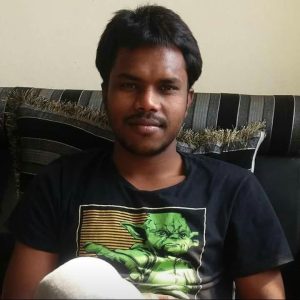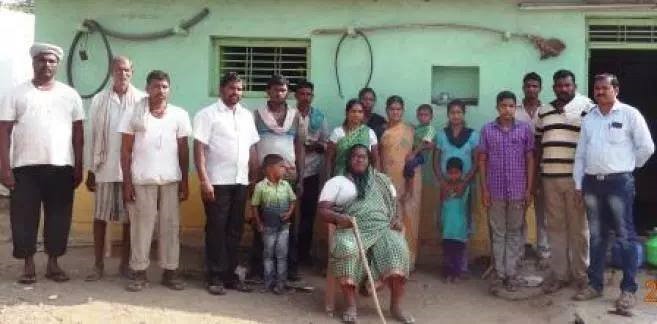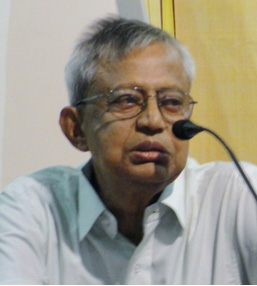Jitendra Suna
 Orissa as a separate state was established in 1 April 1936. There is widespread celebration of Utkal Divas among the Oriyas1 in Orissa and as well as outside Orissa. The academic spaces are not free from this. Oriya students from various campuses such as JNU, Hyderabad, Pondicherry and other universities also celebrate this day as Independence Day. When I said Oriya I am not saying that all people who are staying in Orissa are Oriya. By saying Oriya, I am basically referring to the people who live in coastal Orissa.
Orissa as a separate state was established in 1 April 1936. There is widespread celebration of Utkal Divas among the Oriyas1 in Orissa and as well as outside Orissa. The academic spaces are not free from this. Oriya students from various campuses such as JNU, Hyderabad, Pondicherry and other universities also celebrate this day as Independence Day. When I said Oriya I am not saying that all people who are staying in Orissa are Oriya. By saying Oriya, I am basically referring to the people who live in coastal Orissa.
At this juncture it is necessary to ask some basic questions, such as: is it really an independence day, and if so, for whom? Are Bahujans (SC, ST, OBC and minorities) free from the slavery of caste and Brahminism in Orissa? Are women free from the shackles of Brahminism which is the worst form of patriarchy in the world? Since Dalits and Adivasis form a major section of Orissa population, where are the heroes of Adivasis like Laxman Naik, Rendo Majhi, Birsa Munda and many others? What are the conditions of Dalit-Adivasis in Orissa?
Let me locate the emergence of the state formation movement in a proper historical context. Brahmin historians, political scientists, sociologists and the state machineries of Orissa have presented a glorified history, culture and religion, while hiding the heinous crimes they perpetrate on Bahujans. Let us revisit our commonsensical constructed memory which is the product of Brahminical hegemony.
In the colonial period, when Brahmins, Karans and Khandayats of coastal Odisha realized that they are not getting anything being with Bengal Presidency, they started imagining a separate state where they could be rulers and started demanding it. This agitation or separate state movement started with the denigration and exclusion of Bahujan and anti-caste movements such as the Mahima movement. Subsequently, they made Bhima Bhoi as synonymous with Hinduism, they Brahminized him. They characterized Mahima movement (Mahima Dharma) as a sect of Hinduism. Through the separate state movement Brahmin-Karan-Khandayats were able to establish complete hegemony over the Bahujan. They organized the first riot against Muslims around 1917 (in coastal Orissa).
With all Kings, Brahmins had placed themselves in the colonial state apparatus and established themselves in all influential spheres of life. They had taken the benefit of colonial education and monopolized it. Then they had established Oriya as the state language, relegating all dalit-adivasis languages to the margins. Through Oriya, they supply the Ramayana, Mahabharat, and other Puranas. Language became the carrier of Brahminism. This is because the Brahmins had never allowed Bahujans to read and write. They had monopolized all reading and writing. That is how they had produced the Brahmins’ execrable narratives of fantasy, imagination and all kinds of ridiculous superstition and justification of caste system, widow burning, Devadasi system and all other kinds of oppressive culture, religion and tradition. People of Orissa are still victims of this narrative of Brahmins, but still there is glorification of the Devadasi system, a system where women from Bahujan communities were forced to dance in temples. Brahmins forced Bahujan women into sexual slavery. Even today all this is celebrated in the popular Brahminical culture of Orissa in the form of music and arts.
Brahmins-Karans, former Kings, and landlords started the movement in Cuttack, Puri, Bhubaneswar to restore their Oriya Brahmin language and Brahmin-Kshatriya glory. Subsequently, Congress and Mr. Gandhi2 appeared in the politics of Orissa, and they joined hands with the separate state movement. All Das’, Mahapatras, Mishras, Acharyas, Pattnaiks and other upper castes started a movement to establish a Brahmin raj again. This insecurity of Brahmin-Kshatriyas multiplied especially when they became aware about the Muslim rule in Orissa. Muslim rule somehow created a crisis among the Brahmin-Kshatriya rulers. Please note, crisis in the realm of rule and not in the hegemony (society). However, Brahmins have always reinvented themselves and tried to maintain their hegemony in a constant position in all stages of Orissa history, especially after the decline of Buddhism3.
They had started establishing ‘Bhagvat Tungi’ in every village, built Jagannath temples everywhere. The British appointed Brahmins-Karans in the areas where Dalit-Adivasis were in a majority — for example in Western Orissa and South Orissa. They tried their best to establish Brahminic hegemony and eventually succeeded in their efforts. One can observe it from the work of Congress and other such organisations like, Utkal Sammilani and other Brahmin-Savarna outfits. They deliberately did not introduce the anti-caste movements4 that were going on in Maharashtra, Madras Presidency and other provinces. Utkala Sammilani, Congress and the Upper castes systematically manipulated the Bahujans and used them as foot-soldiers. After the establishment of the separate state of Orissa on April 1, 1936, Brahmins and their allied Kings and zamindars were able to create a hegemonic place called Orissa. After the departure of British, it has become a monopoly space for Brahmins-Karans. What happened in all these years starting from the 1936 to 2017 is the rule of Brahminism and of Brahmin-Dvija. See the list below, how many Bahujans were the rulers of this state-
1. H. Mahatab, 1946-1950
2. N. Chaudhury, 1950-56
3. H. Mahatab, 1956-61
4. Biju Patnaik, 1961-63
5. B. Mitra, 1963-65
6. Sadashiva Tripathy, 1965-67
7. Rajendra N. Singh Deo, 1967-71
8. Biswanath Das, 1971-72
9. Nandini Satpathy, 1972-1976
10. Binayak Acharya, 1976-77
11. Nilamani Routray, 1977- 1980
12. Janaki B. Patnaik, 1980-89
13. Biju Pattnaik, 1990-95
14. J. B. Patnaik, 1995-99
15. G. Gamang, 1999-1999
16. H. Biswal, 1999-2000
17. Naveen Patnaik, 2000-continuing…
Almost all the chief ministers in the above list were Brahmin-Dvija. One or two from Bahujan communities were appointed for temporary periods. There can be a simple explanation that since there is no caste discrimination there is no anti-caste consciousness. But it is not as simple as that. It has a historical meaning. Brahmins-Karans have enslaved Bahujans, hidden the history and struggle of anti-caste thinkers like Phooley, Savitri Bai, Babasaheb Ambedkar and Periyar from Dalit Bahujan discourse. They have made ‘Bhima Bhoi’ who fought against Brahminism, an incarnation and a part of Hinduism. Brahminism has a complete grip on Orissa, and probably that is why they never allowed Dalit-Adivasis to acquire education.
The complete monopoly of Brahmin-Karan-Khandayat in every field i.e., education, government institutions, industries and all other aspects led to the complete disarmament and exclusion of Bahujans in all fields. As a result, there is only hyper caste consciousness of Brahmins-Dvija and no anti-caste consciousness of Bahujans in Orissa. They are burning down Dalits bastis, and forcibly displacing Adivasis from their lands. They terrorized, murdered, raped Dalit-Adivasi Christians in Kandhamal. More than 600 villages were destroyed, 5600 houses were looted and burnt, 54000 people were rendered homeless. Hindus in Kandhamal destroyed 295 churches in 2007-08. Every day there is a crime against Dalits in Orissa. Untouchability, caste practices and atrocities are rampant.
Now the question is: are these people really free? Now you tell me, which independence are you celebrating and what is the idea of Utkal Divas? How are you free individuals and a free society? In the name of Utkal Divas, in the name of Orissa day, is this not a celebration of hyper Brahminism? Is it not a celebration of Castiesm? Is it not a celebration of Brahminical exploitation, domination, subjugation and exploitation of masses?
The inception of the Oriya Nationalism/regionalism or linguistic chauvinism is a naked form of Brahminism in Orissa, which enables the creation of a total grip/monopoly of Brahmins-Dvija hegemony in all spheres of life. Therefore, the celebration of Utkal Divas is not only the celebration of Brahminism but promotion and glorification of the most oppressive system of the world.
~
Notes
1. It is a Brahminical construction or misconception that all those who come from Orissa are speakers of Oriya language. Brahmins have misrepresented that Orissa has only one language that is Oriya; however, the fact is that there are many languages of Dalit Adivasis in Orissa which are not Oriya. And also the language of Western Orissa and South Orissa is different from that of the Coastal region. These two areas are essentially Dalit-Adivasis majority areas. Here I have used Oriyas to referring to the people who live in coastal Orissa only.
2. I have used Babasaheb’s usage of the term Mr. Gandhi, to M.K. Gandhi.
3. It is important to note that before Hinduism/Brahminism, Buddhism was the religion of the masses in Orissa especially after Samrat Ashoka. That is why even after the counter revolution of Brahmin-Kshatriyas in the 5-6th century AD, and especially after Pushyamutra Sunga, there are plenty of Buddhist evidences of sculpture, art, architecture, statues, Biharas across Orissa. There are places in western Orissa such as Asurgarh(fort of Asuras), Junagarh (old fort), Ranipur Jharial and many others where we can find the ruins of Bahujan history, and Buddhist heritage.
4. When Ambedkar and Periyar started the anti-caste movement in India, Brahmins were terrified and they wanted to stop it from becoming a pan-Indian phenomenon. That’s why Congress and Gandhi went to Orissa several times to divert the Dalit-Adivasis from their main agenda. They had organized a few temple entry programmes, which were much more detrimental to the Bahujans. Because of such a strategic conspiracy, Bahujans of Orissa in general and eastern Orissa in particular are still enslaved by Brahminism. They may be free physically but they are mentally enslaved by Hinduism.
~~~
Jitendra Suna is an M.Phil research scholar at the Centre for the Study of Discrimination and Exclusion at Jawaharlal Nehru University, and is a member of BAPSA.










